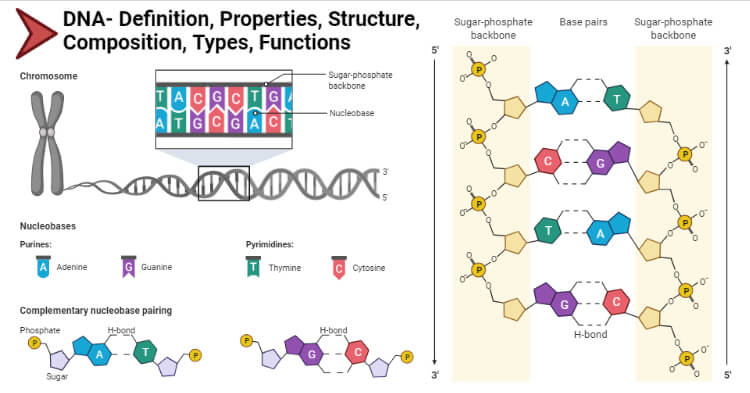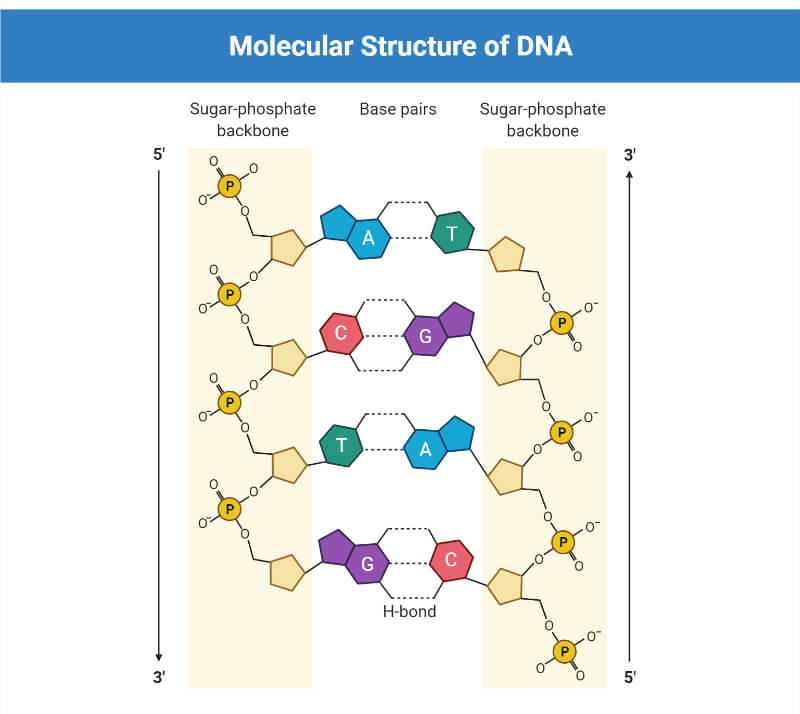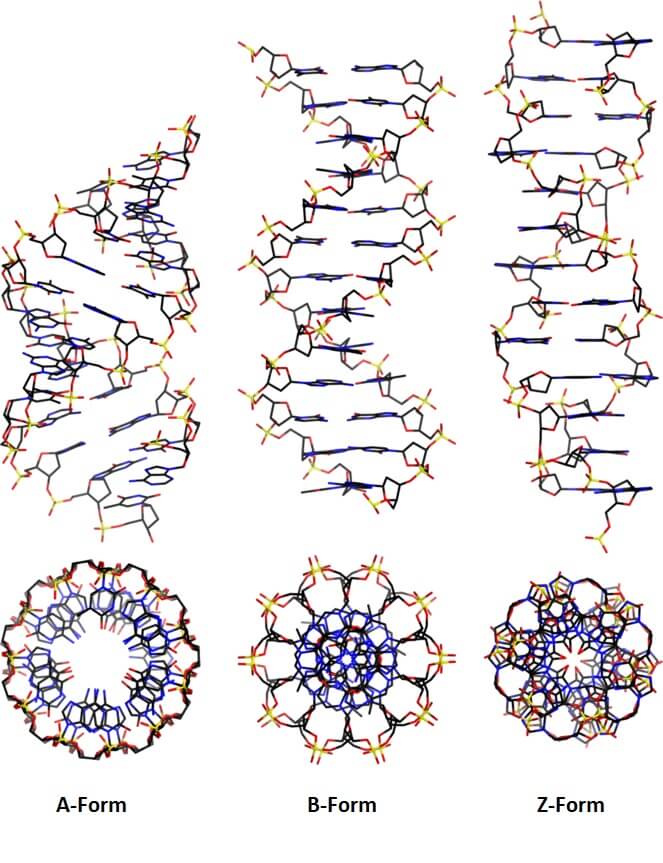DNA (Deoxyribonucleic acid) Definition
Deoxyribonucleic acid (DNA) is the heredity material found in humans and all living organisms. It is a double-stranded molecule and has a unique twisted helical structure. DNA is made up of nucleotides, each nucleotide has three components: a backbone made up of a sugar (Deoxyribose) and phosphate group and a nitrogen-containing base attached to the sugar. Each strand has many nucleotides or says numerous sugar, a phosphate group, and nitrogenous bases. These nitrogenous bases are complementary to the other strand’s nitrogenous base to maintain helical symmetry. Each base pairs are bonded through Hydrogen bonding. These nitrogenous bases are Adenine (A), Guanine (G), Cytosine (C), and Thymine (T), A is complementary to T, and G to C. These bases are responsible for storing the genetic information. Most DNA is located at the cell nucleus so is called nuclear DNA, however, a small amount of DNA is also located in mitochondria, and so is referred to as mitochondrial DNA.

Properties of DNA (Deoxyribonucleic acid)
- DNA is made up of two helical strands that are coiled around the same axis. If coiled from right it is known as right-handed helices DNA and if coiled from left then it is known as left-handed helices. However, the right-handed helices DNA is the most stable and thus the structure of it is to be referred to as the standard.
- The two chains of helices run antiparallel to each other. Thus, one strand runs 5’ to 3’ and another strand runs from 3’ to 5’.
- Both the strands denature on heating and can renature or say hybridize on cooling. However, the temperature on which these strands are separately permanently is referred to as melting temperature and varies according to the specific sequence of DNA.
- For instance, the region of higher concentration of C-G has a higher melting temperature cause these bases are bonded with three hydrogen bonds, which require more energy to break than the region of higher concentration A-T which are bonded only with two hydrogen bonds.
- These nitrogenous bases store genetic information and thus encode for amino acids which give rise to proteins.
Structure and Composition of DNA (Deoxyribonucleic acid)
- DNA is made of two helical chains that intertwine with each other to form a double helix. The most widely accepted structure of DNA is right-handed helix DNA also known as the B-form of DNA, which is 1.9 nm in diameter.
- These helical chains run anti-parallel to each other, one polynucleotide chain runs from 5’ to 3’ and the other polynucleotide chain runs from 3’ to 5’. These chains are connected to each other via nitrogen bases through hydrogen bonding.
- Hydrogen bonding contributes to the specificity of base pairing. Adenine preferentially pairs with Thymine through 2 hydrogen bonds. Similarly, Cytosine preferentially pairs with Guanine through 3 hydrogen bonds.
- We can even say, that the base pairing happens when Pyrimidines pair with Purines because Pyrimidines refers to the single ring structure of Thymine and Cytosine and Purines refers to double-ring structures, Adenine and Thymine.
- The base pairs A = T and G ≡ C are known as complementary base pairs. Hence, the amount of Adenine is equal to the amount of Thymine, and the amount of Guanine is equal to the amount of Cytosine.
- The geometry of the DNA is influenced by the distance between the backbones and the angle at which the nitrogenous bases are attached to the backbone.
- The major groove occurs when the backbones are far apart from each other and the minor groove occurs when they are close.
- The regularity of the helical structure forms two repeating and alternating spaces: Major and Minor grooves.
- These groves act on base-pair recognition and binding sites for protein, the major groove contains base pair specific information while the minor groove is largely base-pair nonspecific, caused by protein interactions in the grooves
- The double-helical structure of DNA is highly regular, each turn of the helix measures approximately 10 base pairs. In addition to hydrogen bonding in between the bases, the staging of bases also stabilizes the structure, there are pi-pi interactions between staged aromatic rings of the bases.
- The distance between each turn is 3.4 nm.
- The major groove is 2.2 nm wide and the minor groove is 1.1 nm wide.

Types of DNA on the basis of forms
1. A-form
- The major difference between the A and B forms of DNA is the conformation of the deoxyribose sugar ring. For B form, it is in the C2 endoconformation, while in A form it is in the C3 endoconformation.
- Another important difference between A and B-form is the arrangement or say placement of nitrogenous base pairs within the duplex.
- In B-form, the base pairs are almost in the center over the helical axis, whereas in A-form, the base pairs are diverted away from the central axis towards the major groove.
- The distance between two base pairs is 0.29 nm. One turn of the helix contains 11 base pairs with a length of 2.8 nm
- Shorter than B-form of DNA. However, the helical width is 2.3 nm which is more than B-form.
- Narrow and deep major groove and wide and shallow minor groove.
- This form of DNA is favored by low hydration and by repeating units of purines or pyrimidines.

Figure: Types of DNA on the basis of forms. Image Source: Mauroesguerroto.
2. B-form
- The standard structure of DNA that is commonly known, was described by Watson and Crick and is a right-handed double helix.
- The double-helical chains run antiparallel to each other, one running from 5’ to 3’ and another running from 3’ to 5’ and are joined together via complementary nitrogenous base pairing.
- Based upon Chargaff’s rules, bases coherent with another, only when one purine of one strand pairs with one pyrimidine of another strand. A with T and G with C
- The pair formed is a keto base pair, with an amino base, a purine with a pyrimidine.
- The two strands of the DNA molecule are plectonemic coil meaning that these two strands are coiled around the same axis and are intertwined with each other.
- The consequence of this plectonemic coil is that these two strands can’t be separated without the DNA rotating.
- The distance between the base pairs is 0.34 nm. One turn of the helix contains 10 base pairs with a length of 3.4 nm.
- This form of DNA is 1.9 nm in diameter, which means the width of the helix is 1.9 nm.
- The wide and shallow major groove of 2.2 nm, making it easily assessable to proteins, and narrow and minor groove of 1.1 nm.
3. Z-form
- It is a left-handed helix and is a very different structure when compared with the A and B-form.
- This form of DNA can form when the DNA is in alternating purines-pyrimidines sequences.
- The backbone is not a smooth helix but an irregular zig-zag, which is resulted from alternating sequences of purines and pyrimidines.
- The B form DNA can take the Z form when proteins are bound to DNA in one helical conformation and force the DNA to adopt a different conformation.
- This adoption happens at the G nucleotide, the sugar in this form is of C3 endoconformation and the guanine base is in the synconformation.
- The result of which places the guanine back over the sugar ring, which is unusual than the B and A form.
- It is long and thin than the B and A forms.
- The helical width is 1.8 nm, being the smallest among the three forms.
- The distance between the base pairs is 0.37 nm. One turn of the helix contains 12 base pairs with a length of 4.56 nm.
- The major groove is flat and the minor groove is narrow and deep.
Types of DNA on the basis of location
1. Nuclear DNA
- As the name suggests, these DNAs are located inside the nucleus organized in the chromosome.
- These chromosomes are 43 pairs in humans and are linear with open ends and contain 3 billion nucleotides.
- Nuclear DNA houses genes that are transcribed into mRNA and ultimately translated to proteins, that are necessary for the functioning and maintaining the integrity of the cell.
- It is inherited from both parents, so this is diploid and considered unique to each individual except for identical twins.
- It is usually present in two copy numbers per cell
2. Mitochondrial DNA
- It is located inside the mitochondria.
- It is small and circular in structure
- It is inherited only from the mother, so is a haploid.
- It is present in a much higher copy number. i.e., 100-10,000 per cell.
- It has only 16,500 base pairs and encodes proteins that are specific for mitochondria. These proteins are vital for producing energy.
- Mitochondrial DNA encoded proteins also play a pivotal role during intracellular protein transport.
Functions of DNA (Deoxyribonucleic acid)
- DNA stores complete genetic information that requires to specify an organism.
- It is the source of information that is needed in order to synthesize cellular proteins, and other macromolecules required by an organism.
- It is responsible for identifying and determining the individuality of the given organism.
- It can also be taken as a targeted element during the diagnosis of a particular disease.
- It can replicate to give rise to two daughter cells and transfer one copy to the daughter cells during cell division. Thus, maintaining the genetic materials from generation to generation.
References
- https://bio.libretexts.org/Bookshelves/Genetics/Book%3A_Working_with_Molecular_Genetics_(Hardison)/Unit_I%3A_Genes_Nucleic_Acids_Genomes_and_Chromosomes/2%3A_Structures_of_Nucleic_Acids/2.5%3A_B-Form_A-Form_and_Z-Form_of_DNA– 5%
- https://www.sciencedirect.com/topics/neuroscience/nuclear-dna- 1%
- https://lauterdar.com/sitefinity/docs/default-source/biotech-basics/dna-replication34a-4599bff.pdf?sfvrsn=78563407_6- 1%
- https://www.coursehero.com/file/p1hc1f5e/Major-groove-forms-when-the-two-backbones-are-far-apart-from-each-other-Minor/- <1%
- http://atlasgeneticsoncology.org/Educ/DNAEngID30001ES.html- <1%
- https://medlineplus.gov/genetics/understanding/basics/dna/- <1%
- https://www.coursehero.com/file/42035440/Module-3-docx/- <1%
- https://tardigrade.in/question/the-length-of-one-turn-of-the-helix-in-a-b-form-dna-is-approximately-5sff2neg- <1%
- https://www.genome.gov/genetics-glossary/Mitochondrial-DNA- <1%
- https://www.visiblebody.com/learn/biology/dna-chromosomes/dna-structure- <1%
- https://opentextbc.ca/biology/chapter/9-1-the-structure-of-dna/- <1%
- https://worldtoday00.blogspot.com/2016/01/dna.html- <1%
- http://www.tulane.edu/~biochem/nolan/lectures/rna/DNAstruc2001.htm
- http://people.bu.edu/mfk/restricted566/dnastructure.pdf
- http://eagri.org/eagri50/GBPR111/lec15.pdf
- https://www.ancestry.com/lp/dna-function
- http://www.bch.cuhk.edu.hk/vr_biomolecules/different-form-of-dna.html
- https://www.britannica.com/science/heredity-genetics/Structure-and-composition-of-DNA
